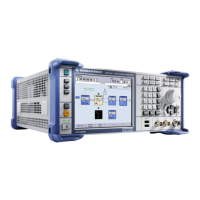Instrument Function
R&S
®
SMBV100A
168Operating Manual 1407.6062.32 ─ 08
"User"
Measurements source is any freely selectable source. The frequency
is entered manually under frequency (e.g. for measurement of amplifier
gain with 2 sensors).
SCPI command:
SENSe<ch>[:POWer]:SOURce on page 491
Frequency - Power Sensors
Source User only
Enters the frequency for measurement source "User".
SCPI command:
SENSe<ch>[:POWer]:FREQuency on page 490
Level Offset - Power Sensors
Activates and defines a level offset which is added to the measured value. This allows
e.g. an attenuator in the signal path to be taken into account. The offset is always entered
in dB, irrespective of the selected unit for result display.
SCPI command:
SENSe<ch>[:POWer]:OFFSet:STATe on page 491
SENSe<ch>[:POWer]:OFFSet on page 490
Auto Once
Searches for the optimum filter length for the current measurement conditions and indi-
cates value in the "Filter Length" field above.
SCPI command:
SENSe<ch>[:POWer]:FILTer:SONCe on page 489
Filter Length - Power Sensors
Selects the filter length used for measurement. The filter length is the multiplier for the
measurement time and thus directly influences it.
The averaging filter is used to reduce fluctuations in the measured result to the extent
desired. Such fluctuations can be caused by inherent noise of the measuring instrument,
modulation of the measurement signal or beats from the superposition of adjacent car-
riers. A more stable display has to be traded off against longer measurements. The mea-
surement result is obtained from a two-stage averaging process.
Note: Longer measurements does not mean that it takes longer to display a new result,
but rather that it takes longer for the result to settle when the power changes.
Measurements are continuously repeated in a predefined time window. The measure-
ment result is obtained by averaging the measured values for the last 2N time windows.
The number N is the filter length, the factor of 2 arises because the output signals from
the microwave detector to suppress low-frequency noise are chopped at the same rate
as the time windows, which means that an independent measured value can only be
obtained from two consecutive values. As the filter length is the multiplier for the time
window it directly influences the measurement time.
The filter length can be selected automatically or can be manually set to a fixed value.
As a preliminary, you should always check if the auto mode is giving satisfactory results
because you will always have to adjust an optimal, manual filter-length setting if the power
is not constant.
RF Signal and Analog Modulations - RF Block

